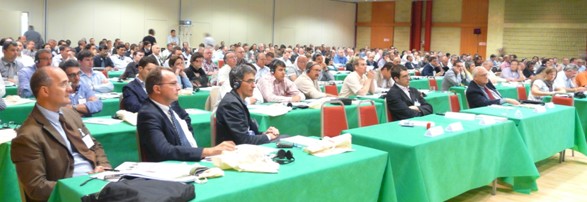How to Enhance Dairy Performance by Optimizing Dietary fibre utilization?
On May 12th, took place in Bologna, Italy, a scientific symposium dedicated to the role of plant fibre in dairy production, organized by University of Bologna with the support of Lallemand Animal Nutrition and Filozoo Italy.
 Titled: "Fibre: a key element for dairy production profitability?", this event, featuring world-leading experts in dairy nutrition and microbiology: Prof. Formigoni from University of Bologna, Prof Sniffen (ex-Cornell), Prof Mertens (Mertens Innovation & Research), Dr Bach (IRTA), and Dr Chaucheyras-Durand (INRA-Lallemand), and Chaired by Professor Savoini from University of Milan, attracted over 300 participants from all over Italy as well as 24 different countries around the world. Offering a good combination of high level scientific content and practical field recommendations delivered by top-notch scientists in the field, the symposium generated rich and enthusiast discussions, and will certainly lead to the development of new feeding strategies and herd management practices.
Titled: "Fibre: a key element for dairy production profitability?", this event, featuring world-leading experts in dairy nutrition and microbiology: Prof. Formigoni from University of Bologna, Prof Sniffen (ex-Cornell), Prof Mertens (Mertens Innovation & Research), Dr Bach (IRTA), and Dr Chaucheyras-Durand (INRA-Lallemand), and Chaired by Professor Savoini from University of Milan, attracted over 300 participants from all over Italy as well as 24 different countries around the world. Offering a good combination of high level scientific content and practical field recommendations delivered by top-notch scientists in the field, the symposium generated rich and enthusiast discussions, and will certainly lead to the development of new feeding strategies and herd management practices. 
Will dietary inclusion of probiotic, prebiotic, synbiotic and phytogenic plants be useful in improving the fibre digestion and nutritive value of the highly fibrous crop residues?

One way to enhance fibre utilization by use of isolates of fibre-degrading bacteria.For this first we have to isolate the fibre-degrading bacterial strains from freshly collected rumen liquor or even dung sample using carboxymethylcellulose as substrate and we can preserve this isolates in deep refrigeration system in glycerol or even we can keep the isolates in lyophilised form for future use as oral probiotic in ruminants. As per my research it has been shown a increase in ADF as well as NDF utilization with increase in DMI, body weight gain and milk production as well along with increase in total ruminal microbial population and ruminal fungal population.
So we can take this aspect seriously for future use as a tool for enhancement of fibre utilization in dairy animals.
We do agree that role of cellulase, hemecellulase with additional blend of proteolytic enzymes provide response in milk production. Where as dry matter quality also plays always plays vital role in milk production.
During this meeting, discussions show that fibre plays a very important role for ruminants for dietetic and nutritional reasons.
Fiber degradation depends on many factors and can be modulated from the crop to the animal.
At animal level, fibre degradation occurs mainly in the rumen. Increased this parameter can only be achieved with perfect rumen conditions. Rumen modifiers like Monensin or Live Yeast (speakers didn’t speak about exogenous enzymes) can offer some possibilities to manage rumen microflora. As an example, Levucell SC, a rumen specific live yeast, demonstrated, in vitro and in vivo, a great impact on NDF degradation of different forages like corn silages, alfalfa hays, straw and others compounds widely used in TMR formulation.

To Mr Kimono: The live yeast SC I-1077 has been tested in vivo and in vitro on various types of forages:
, it has been shown that fibre degradation improvement was even higher when the forage initial digestibility was bad (Guedes et al.). I suggest these references
Chaucheyras Durand F., A. Ameilbonne, N. D. Walker, P. Mosoni and E. Forano.
Effect of a live yeast, Saccharomyces cerevisiae I-1077 on in situ ruminal degradation
of alfalfa hay and fiber-associated microbes. Journal: J. Anim. Sci. 88 (S2)/J. Dairy Sci. 93 (S1): 145.
Guedes C. M., D. Gonçalves , M. A. M. Rodrigues and A. Dias-da-Silva.
Effect of a Saccharomyces cerevisiae yeast on ruminal fermentation and fibre
degradation of maize silages in cows. Journal: Anim. Feed Sci. Technol. 145 :27-40.
I think this was a very useful meeting of minds and the results of their discussions are especially appropriate for livestock keepers in the tropics where fibre digestibility is still a problem. I would wish to know how the yeast specific can be obtained in Kenya since I see enormous possibilities of applying it. Additionally, on what type of fibre material has it been tested in terms of the diets given to the ruminants. Was the basal diet made up of wheat or rice straw, etc. Is it possible to have the proceedings availed at some point for us to benefit from the experience of these eminent persons.











.jpg&w=3840&q=75)